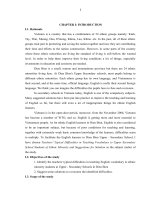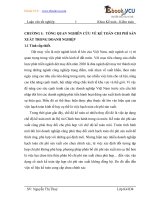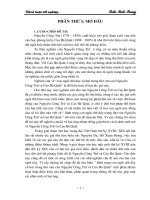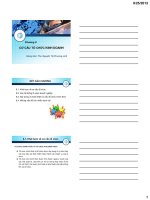slide 1 to our class 122 teacher nguyen thi thuy bong cao ba quat upper secondary school team a team b waving shaking hands raising one’s hand nodding clapping one’s hands pointing non verbal ex wav
Bạn đang xem bản rút gọn của tài liệu. Xem và tải ngay bản đầy đủ của tài liệu tại đây (993.33 KB, 29 trang )
<span class='text_page_counter'>(1)</span><div class='page_container' data-page=1>
To our class, 12/2
</div>
<span class='text_page_counter'>(2)</span><div class='page_container' data-page=2>
Team A
Team B
- Waving
- Shaking hands
- Raising one’s hand
- <sub>Nodding</sub>
</div>
<span class='text_page_counter'>(3)</span><div class='page_container' data-page=3></div>
<span class='text_page_counter'>(4)</span><div class='page_container' data-page=4>
non-verbal
Ex: Waving, clapping one’s hands and nodding
are ...forms of communication
get/attract someone’s attention
informality
non-verbal
≠ verbal
( )n
(a) = impolite
(a) (a)
(exp):
1.
2.
3.
4. rude
:sự không
nghi thức, sự
thân mật
(a)
</div>
<span class='text_page_counter'>(5)</span><div class='page_container' data-page=5>
True/False Statement Prediction
1. At a noisy party, you can clap your hands or whistle to
attract your friend’s attention.
2. We can raise our hands to show that we need
assistance.
3. It is considered impolite to whistle or clap our hands to
get the waiter’s attention in the restaurant.
4. It is unacceptable for the teacher to point at her/his
students.
5. To get your friend’s attention, you shouldn’t point at
the person or thing you want her/him to look at.
F
T
F
T
</div>
<span class='text_page_counter'>(6)</span><div class='page_container' data-page=6>
Fill in the gaps with the suitable words or phrases in the text:
1. We can use either verbal or ___________ communication to
attract someone’s attention .
2. ____________________ and waving are considered to be big ,
obvious non- verbal signals .
3. If we want to _______________________ , we wait until he
passes us , catch his eyes , and nod slightly to let him know .
4. If you are ______________ the schoolyard and see your teacher
approaching you, you can use a _________________ to attract
his or her attention .
5. __________ someone is usually considered rude .
<i>non- verbal</i>
<i>Jumping up and down</i>
<i>attract the waiter’s attention</i>
<i>walking across</i>
<i>small friendly wave</i>
<i>Pointing at</i>
</div>
<span class='text_page_counter'>(7)</span><div class='page_container' data-page=7>
Read the passage carefully and choose the best answers:
1. ... is considered the most common way of getting someone’s attention.
A. raising one’s hand B. pointing C. waving D. clapping one’s hand
2. You can jump up and down and wave as hard as you can to attract your brother’s
attention ...
A. at the airport B. in a restaurant C. at a noisy party D. in the schoolyard
3. The word “approaching” in the fourth paragraph means ...
A. walking B. passing C. crossing D. coming near
4. Which of the following is NOT true?
A. We can raise our hand slightly to attract the waiter’s attention.
B. A small friendly wave to attract the teacher’s attention in the schoolyard is
acceptable.
C. The teacher can point at a student in class to get his/her attention.
D. Pointing at someone is usually considered polite.
5. The best title for the passage is ...
</div>
<span class='text_page_counter'>(8)</span><div class='page_container' data-page=8>
<b>1</b>
<b>6</b>
<b>3</b> <b>4</b>
<b>5</b>
<b>2</b>
<b>What do these gestures mean? </b>
<b>Let’s choose the correct answers .</b>
</div>
<span class='text_page_counter'>(9)</span><div class='page_container' data-page=9>
Yes? or No?
In Greece , a <i>nod </i>means ...
Yes
</div>
<span class='text_page_counter'>(10)</span><div class='page_container' data-page=10>
She wants
to say No.
In Greece , a<i> nod</i> means ...
No
</div>
<span class='text_page_counter'>(11)</span><div class='page_container' data-page=11>
She wants to
say No, not
<i>Yes.</i>
In Greece , a <i>nod</i> means <i>No</i> , not <i>Yes</i> .
</div>
<span class='text_page_counter'>(12)</span><div class='page_container' data-page=12>
<i>Yes</i> ?or <i>Money</i>
?
In Tonga ,
<i>raised eyebrows</i>
mean ...
Yes .
</div>
<span class='text_page_counter'>(13)</span><div class='page_container' data-page=13>
He wants to
say <i><b>yes</b></i>
In Tonga ,
<i>raised eyebrows</i>
mean ...
Yes .
Money .
</div>
<span class='text_page_counter'>(14)</span><div class='page_container' data-page=14>
In Tonga ,
<i>raised eyebrows</i>
mean
<i>yes , </i>
not
<i>money.</i>
He wants to say
<i><b>yes.</b></i>
</div>
<span class='text_page_counter'>(15)</span><div class='page_container' data-page=15>
In the Netherlands, <i>tapping your elbow</i> means ...
The third person (a friend of yours, for example)
doesn’t want to spend money .
The third person can’t help you anything .
</div>
<span class='text_page_counter'>(16)</span><div class='page_container' data-page=16>
In the Netherland, <i>tapping your elbow</i> means ...
The third person (a friend of yours, for example)
can’t help you anything .
The third person doesn’t want to spend money .
You can’t
depend on
that man .
</div>
<span class='text_page_counter'>(17)</span><div class='page_container' data-page=17>
Sorry. You are wrong !
In the Netherland, <i>tapping your elbow</i> means ...
The third person (a friend of yours, for example)
doesn’t want to spend money .
The third person can’t help you anything .
You can’t
depend on
that man .
</div>
<span class='text_page_counter'>(18)</span><div class='page_container' data-page=18>
In Italy, <i>flicking your chin</i> means ...
I don’t know.
Go away !
Go
away
!
I don’t
</div>
<span class='text_page_counter'>(19)</span><div class='page_container' data-page=19>
In Italy, <i>flicking your chin</i> means ...
Go away !
I don’t know.
Go
away
!
</div>
<span class='text_page_counter'>(20)</span><div class='page_container' data-page=20>
Sorry. You are wrong !
<i><b>Go </b></i>
<i><b>away </b></i>
<i><b>!</b></i>
In Italy , <i>flicking your chin</i> means ...
I don’t know
</div>
<span class='text_page_counter'>(21)</span><div class='page_container' data-page=21>
<b>No? Yes ?</b>
<b>Come here ? </b>
In Germany, <i>tossing your head</i> means ...
No
Yes
</div>
<span class='text_page_counter'>(22)</span><div class='page_container' data-page=22>
<b>She wants me to </b>
<i><b>come here . </b></i>
In Germany, <i>tossing your head</i> means ...
Come here !
Yes
No
</div>
<span class='text_page_counter'>(23)</span><div class='page_container' data-page=23>
Sorry. You are wrong !
<b>She wants me to </b>
<i><b>come here . </b></i>
In Germany, <i>tossing your head</i> means <i><b>come here</b></i> <i>! </i>, not
</div>
<span class='text_page_counter'>(24)</span><div class='page_container' data-page=24>
<i>There’s a </i>
<i>telephone call or </i>
<i>you are crazy?</i>
In most parts of Europe ,<i>circling your head</i> means ...
there’s a telephone call
</div>
<span class='text_page_counter'>(25)</span><div class='page_container' data-page=25>
Sorry. You are wrong !
You mean
<i>you are crazy. </i>
In most parts of Europe ,<i>circling your head</i> means ...
there’s a telephone call
the person is crazy .
</div>
<span class='text_page_counter'>(26)</span><div class='page_container' data-page=26>
You mean
<i>you are crazy. </i>
In most parts of Europe ,<i>circling your head</i> means ...
the person is crazy
there’s a telephone call .
</div>
<span class='text_page_counter'>(27)</span><div class='page_container' data-page=27>
<b>HOMEWORK</b>
</div>
<span class='text_page_counter'>(28)</span><div class='page_container' data-page=28></div>
<span class='text_page_counter'>(29)</span><div class='page_container' data-page=29></div>
<!--links-->









